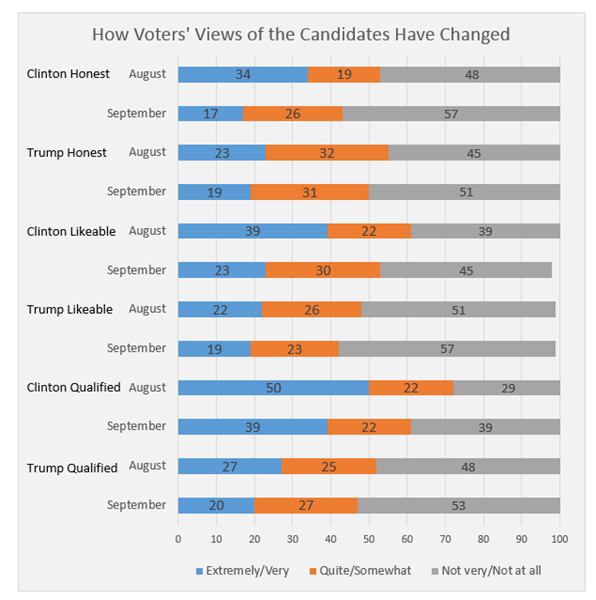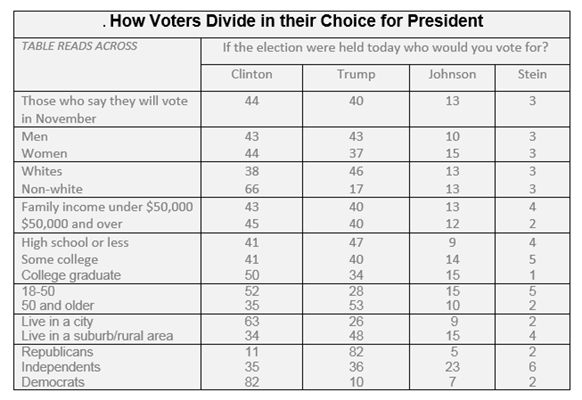Election 2016 – Presidential Race Tightens Ahead of the First Debate
9/26/2016
Less than eight weeks before Election Day, Hillary Clinton and Donald Trump are locked in a close contest in which the challenge from third party candidates could make a difference. In the latest national poll from the Fishlinger Center for Public Policy Research at the College of Mount Saint Vincent, Mrs. Clinton, the Democratic nominee is supported by 44 percent of likely voters, while 40 percent prefer Mr. Trump.
The race has clearly grown tighter in recent weeks. National polling averages have narrowed in the last month, and recent polls in several battleground states have shown the race to tighter as well.
In the Fishlinger poll, Gary Johnson, the Libertarian candidate has the support of 13 percent and the Green Party nominee, Jill Stein, gets 3 percent. Mr. Johnson is hoping to take part in the presidential debates, however he has not yet reached 15 percent in an average of the major media polls. So, Mr. Johnson will not be included in the debate on Sept. 26 and his running mate, William Weld, also does not qualify for the Vice Presidential debate on Oct. 4.
Voters do not seem to be particularly pleased with either major party candidate. Both candidates face doubts about their honesty. Measures of the candidates’ likeability and qualifications have declined.
Mrs. Clinton continues to be confronted with questions about her family’s foundation, her work at the State Department, and her use of a private email server while Secretary of State. And after months of questions from Mr. Trump about her health and stamina, she nearly collapsed at the 9/11 commemoration in New York City with pneumonia.
Mr. Trump has also been facing questions about his foundation, along with persistent requests for his tax returns. Recently, while retreating from the claim questioning President Obama’s citizenship, he charged Mrs. Clinton with initially raising the question during her 2008 primary battle with Mr. Obama.
The Fishlinger Center for Public Policy Research at the College of Mount Saint Vincent seeks to foster meaningful dialog on key public policy issues through independent, objective public opinion research. The national surveys of 2016 focus on political issues in the United States ahead of the Presidential election in November.
Before the start of the primaries, the Fishlinger Center conducted an online poll January 4 to 25, 2016 with 1,000 adults nationwide, of whom 912 said they were registered or planned to register to vote. The second poll was conducted June 8 to July 5 with 1,000 adults nationwide, of whom 845 said they planned to vote in the presidential election in November. After the Republican and Democratic conventions, a third poll was conducted Aug. 15 to Sept. 1 with 514 adults nationwide, of whom 453 said they were likely to vote in November. The latest poll, conducted Sept. 1 to 22 is based on internet interviews with 528 adults or whom 455 said they were likely to vote in November.
Views of the campaign
 The last few weeks have taken a toll on voters’ views of the country’s election process. In the latest poll, a plurality of voters are not satisfied with the process of choosing a president. Independents are particularly unhappy: 57 percent of them are hardly or not at all satisfied with the election process.
The last few weeks have taken a toll on voters’ views of the country’s election process. In the latest poll, a plurality of voters are not satisfied with the process of choosing a president. Independents are particularly unhappy: 57 percent of them are hardly or not at all satisfied with the election process.
State of the Country
Voters’ perception of how the country is doing have also declined. Only a third of voters say the country is headed in the right direction, while 67 percent say it is going in the wrong direction. Voters were more positive about the state of the country last month when 46 percent said it was headed in the right direction while 54 percent disagreed. There still are considerable partisan differences. More than half of Democrats regard the country as going in the right direction, while three-quarters of Republicans and independents think it is moving in the wrong direction.
Perceptions of the Candidates
 Both candidates have taken a hit in recent weeks. The voters’ impressions of Mrs. Clinton and Mr. Trump have declined, although Mrs. Clinton continues to be seen as more qualified and better able to deal with foreign and domestic policy than Mr. Trump.
Both candidates have taken a hit in recent weeks. The voters’ impressions of Mrs. Clinton and Mr. Trump have declined, although Mrs. Clinton continues to be seen as more qualified and better able to deal with foreign and domestic policy than Mr. Trump.
Four in 10 voters consider Mrs. Clinton extremely or very well qualified, down from 50 percent in August, but still ahead of Mr. Trump’s 20 percent. Neither candidate are seen as particularly likeable or honest.
While the contest has gotten tighter, Mrs. Clinton remains the candidate to beat. Like the election forecasters at 538 and The New York Times’s Upshot, voters expect Mrs. Clinton to prevail in November. Fifty-nine percent say Mrs. Clinton will win the election and 37 percent expect Mr. Trump to be the victor.
Profiles of the Candidates’ Supporters
 Despite the voters’ reservations about Mrs. Clinton and Mr. Trump, both candidates have firmed up support from their own party. Mrs. Clinton is backed by 82 percent of Democrats and Mr. Trump is the choice of 82 percent of Republicans. Independents are just about evenly divided: 35 percent for Mrs. Clinton and 36 percent for Mr. Trump.
Despite the voters’ reservations about Mrs. Clinton and Mr. Trump, both candidates have firmed up support from their own party. Mrs. Clinton is backed by 82 percent of Democrats and Mr. Trump is the choice of 82 percent of Republicans. Independents are just about evenly divided: 35 percent for Mrs. Clinton and 36 percent for Mr. Trump.
Mrs. Clinton has the advantage with better educated and younger voters. Non-whites and urban voters are also more inclined to support her. Mr. Trump is preferred by older voters and those living outside cities.
Survey Methodology
The fieldwork for the Fishlinger Center Poll was conducted using a blended national Survey Sampling Inc. panel. Previous surveys are based on online interviews conducted with 912 adults who reported they are registered or plan to register to vote January 4 to 25, with 845 adults who said they plan to vote in the presidential election interviewed online June 8 to July 5, and with 453 adults who said they plan to vote in November interviewed August 15 to September 1. The latest results are based on interviews conducted Sept. 1 to 22 with 455 adults who said they plan to vote in November.
The first and second surveys each have a credibility interval of plus or minus 4.0 percentage points for those who plan to vote in November. The credibility interval for the results from August and September is plus or minus 5.0 percentage points. The credibility interval may be larger for other sub-groups. The polls are subject to other potential sources of error including, but not limited to coverage and measurement error. Data were rim weighted to match the national population on age, sex, Hispanic origin and race. Question wording and topline results are available at fishlingercenter@mountsaintvincent.edu.
About the Fishlinger Center for Public Policy
The Fishlinger Center for Public Policy Research opened in February 2015 at the College of Mount Saint Vincent. The Center, a member of the American Association for Public Opinion Research (AAPOR), conducts deep and broad studies of public opinion on key public policy concerns through independent and objective research conducted by students, faculty, and other members of the academic community.
By providing a forum for discourse that can stimulate intelligent dialog about issues that deeply affect all Americans, the Center illustrates and enhances the relationship between the work of the College and the common good.
About the College of Mount Saint Vincent
Founded in 1847 by the Sisters of Charity, the College of Mount Saint Vincent offers nationally recognized liberal arts education and a select array of professional fields of study on a landmark campus overlooking the Hudson River. Committed to the education of the whole person, and enriched by the unparalleled cultural, educational and career opportunities of New York City, the College equips students with the knowledge, skills and experiences necessary for lives of achievement, professional accomplishment and leadership in the 21st century.
